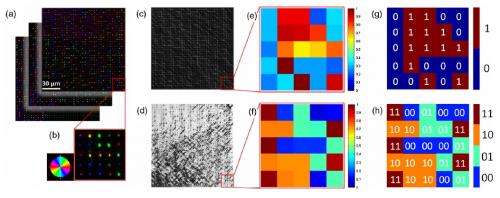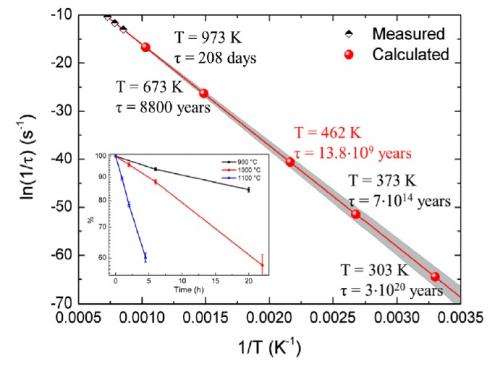February 4, 2014 feature
Optical data storage has virtually unlimited lifetime

(Phys.org) —Data stored on today's CDs and DVDs has a lifetime of several decades before the physical material begins to significantly decay. Researchers are working on prolonging the lifetime of stored data, but so far reaching even 100 years has been challenging. Now in a new study, researchers have demonstrated a data storage technique that has a lifetime of about 3 x 1020 years at room temperature—virtually unlimited—which could lead to a new era of eternal data archiving.
The researchers, Jingyu Zhang, Mindaugas Gecevičius, Martynas Beresna, and Peter G. Kazansky at the University of Southampton in the UK, have published a paper in a recent issue of Physical Review Letters on the new data storage technique.
"In the fifth decade after the invention of the Internet, more and more data is generated in this Information Age," Zhang told Phys.org. "How to store the data while considering the physical decay of storage materials and techniques has attracted much attention. Many individuals, companies and governments are interested in eternal data archiving to store data for military, science, and confidential purposes. Some applications can already be seen in the market; for example, M-disc and others are still under development. There is also a disc by Hitachi which lasts millions of years. We believe we are presenting the ultimate solution for eternal data archiving."
As the scientists explain, there is a general tradeoff in data storage between lifetime and capacity, so that media that store larger amounts of information tend to have shorter lifetimes. For example, physicists have demonstrated the possibility of storing vast amounts of data with individual atoms, yet the storage time is a mere 10 picoseconds at room temperature.
The new optical data storage technique presented here provides both excellent lifetime and capacity. To record data, a femtosecond (fs) laser delivers ultrashort (280-fs, with 1 fs = 10-15 seconds) light pulses onto a piece of quartz. The light pulses create nanogratings—tiny dots—in the quartz, with each dot carrying three bits of information. This triple storage is possible because the laser performs multilevel encoding, so that the dots encode the intensity and polarization of the light in three layers of the quartz. Applying this technique, a disc the size of a CD or DVD with about 1000 layers has a data capacity of hundreds of terabytes, compared with hundreds of megabytes for today's commercial discs.

To determine the lifetime of the optical data storage system, the researchers subjected the information to accelerated aging to obtain the decay rate. The underlying mechanism of decay is the collapse of nanovoids that exist between the nanogratings; when the nanovoids collapse, the nanogratings become unstable and lose their stored data.
The researchers calculated that the decay time of the nanogratings, and thus the lifetime of the data storage system, is about 3 x 1020 years at room temperature, indicating unprecedented high stability. The lifetime decreases at elevated temperatures, but even at temperatures of 462 K (189° C, 372° F), the extrapolated decay time is 13.8 billion years, comparable to the age of the Universe.
Previous optical recording methods have worked similarly to this one, except that the recording procedure used by these methods is so slow that it makes real-world applications unviable. The new method increases the data recording rate by 2 orders of magnitude by eliminating the need for the half-wave plate (which controls polarization) to be rotated. This rotation takes a relatively long time and reduces writing speed. By adding a matrix to the half-wave plate, the researchers enabled motion-free polarization control, greatly increasing the writing speed.
In the future, the researchers hope to make further improvements to the system, such as by improving the capacity by increasing the number of polarization states and intensity states to be exploited. They also plan to further increase the writing speed from its current rate of 6 KB/s to 120 Mbit/s by increasing laser power, among other means.
More information: Jingyu Zhang, et al. "Seemingly Unlimited Lifetime Data Storage in Nanostructured Glass." PRL 112, 033901 (2014). DOI: 10.1103/PhysRevLett.112.033901
Journal information: Physical Review Letters
© 2014 Phys.org. All rights reserved.





















